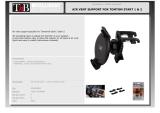
2
Safety and Regulatory
Information
Important Safety Notices and Warnings
Global Positioning System
The Global Positioning System (GPS) is a satellite-
based system that provides location and timing
information around the globe. GPS is operated and
controlled under the sole responsibility of the
Government of the United States of America, who
are responsible for its availability and accuracy.
Any changes in GPS availability and accuracy, or in
environmental conditions, may impact the operation
of your TomTom GO. TomTom B.V. cannot accept any
liability for the availability and accuracy of GPS.
Use With Care
Use of TomTom GO for navigation still means that
you need to drive with due care and attention.
Aircraft and Hospitals
Use of devices with an antenna is prohibited on most
aircraft, in many hospitals and in many other locations.
TomTom GO must not be used in these environments.
Battery
This product uses a Lithium-Ion battery. Do not use
it in a humid, wet and/or corrosive environment. Do
not put, store or leave your product in or near a heat
source, in a high temperature location, in strong
direct sunlight, in a microwave oven or in a pressurized
container, and do not expose it to temperatures over
60
O
C (140
O
F). Failure to follow these guidelines may
cause the Lithium-Ion battery to leak acid, become
hot, explode or ignite and cause injury and/or dama-
ge. Do not pierce, open or disassemble the battery.
If the battery leaks and you come into contact with
the leaked fluids, rinse thoroughly with water and
seek medical attention immediately. For safety
reasons, and to prolong the lifetime of the battery,
charging will not occur at low (below 0
O
C/32
O
F) or
high (over 45
O
C/110
O
F) temperatures.
THE LITHIUM-ION BATTERY CONTAINED IN
THE PRODUCT MUST BE RECYCLED OR
DISPOSED OF PROPERLY. USE TOMTOM
GO ONLY WITH THE SUPPLIED DC POWER
LEAD AND AC ADAPTER FOR BATTERY CHARGING.
To recycle your TomTom GO unit, please see your
local approved TomTom service centre.
This Document
Great care was taken in preparing this manual.
Constant product development may mean that some
information is not entirely up-to-date. No liability
shall be assumed for technical or editorial errors or
omissions contained herein; nor for incidental or
consequential damages resulting from the
performance or use of this material. This document
contains information protected by copyright.
FCC Information to the User
Radio and Television Interference
This equipment radiates radio frequency energy and if
not used properly - that is, in strict accordance with
the instructions in this manual - may cause interferen-
ce to radio communications and television reception.
It has been tested and found to comply with the
limits for a Class B digital device pursuant to part 15
of the FCC Rules. These are designed to provide rea-
sonable protection against harmful interference in a
residential installation. However, there is no guarantee
that interference will not occur in a particular installa-
tion. If this equipment does cause harmful interferen-
ce to radio or television reception, which can be
determined by turning the equipment off and on, the
user is encouraged to try to correct the interference
by one or more of the following measures:
• Reorient or relocate the receiving antenna.
• Increase the separation distance between the
equipment and the receiver.
• If you are using the equipment with a mains adap-
tor, plug it into an outlet which is on a different cir-
cuit from that to which the receiver is connected.
• Consult an experienced radio/TV technician for help.
Important
This equipment was tested for FCC compliance
under conditions that included the use of shielded
cables and connectors between it and the
peripherals. It is important that you use shielded
cable and connectors to reduce the possibility of
causing radio and television interference. Shielded
cables, suitable for the product range, can be obtai-
ned from an authorised dealer.
If the user modifies the equipment or its peripherals
in any way, and these modifications are not
approved by TomTom, the FCC may withdraw the
user's right to operate the equipment.
For customers in the USA, the following booklet pre-
pared by the Federal Communications Commission
may be of help: "How to Identify and Resolve Radio-
TV Interference Problems". This booklet is available
from the US Government Printing Office,
Washington, DC 20402 Stock No 004-000-00345-4.
Do not use this product on board aircraft, or in
hospitals, without first obtaining permission.
FCC Declaration of Conformity
Tested to Comply with FCC Standards for Home or
Office Use.
TomTom GO has been tested to - and complies with -
part 15 of the FCC rules. Operation is subject to the
following two conditions:
1. This device may not cause harmful interference.
2. This device must accept any interference
received, including interference that may cause
undesired operation.
Responsible party:
TomTom, Inc.
150 Baker Ave
Concord, MA 01742
Tel: 978 287 9555
Fax: 978 287 9522
Toll Free: 866 4 TOMTOM (866 4 866 866)
(The Toll Free number does not work outside of the US)
Emissions information for Canada
This Class B digital apparatus complies with
Canadian ICES-003.
Cet appareil numérique de la classe B est conforme
à la norme NMB-003 du Canada.
CE Marking
This product fully satisfies the requirements for CE
marking when used in a residential, commercial or
light industrial environment.
[DL2] R&TTE Directive
This equipment complies with the essential
requirements of EU Directive 99/5/EC (declaration
available at www.tomtom.com).
3.6113_TT GO Manual UK v7 22-04-2004 12:31 Pagina 2



















